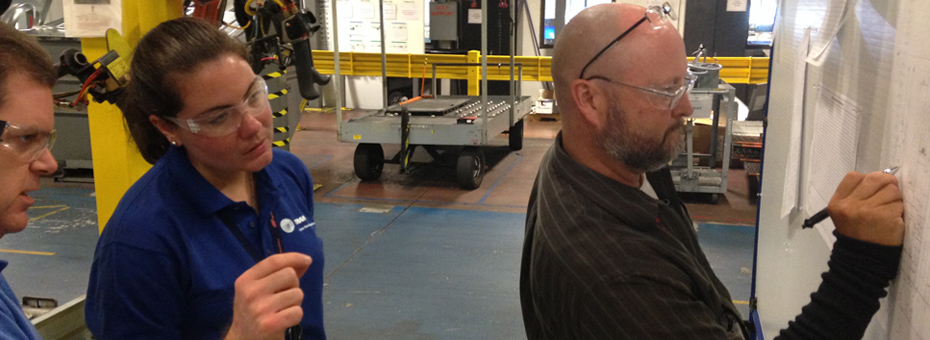As a lean coach in manufacturing, I hear a lot of people express an inability to run different products down one line even though they would like to do so for cost savings purposes (i.e. people, equipment, machines, space, and so on). Most people have never heard of the lean principle of Heijunka, which is about using resources more effectively by sequencing production by sales ratio and then distributing the workload to people in order to achieve maximum cost-saving benefits as described above.
If you find yourself struggling with how to do it, here’s a scenario I hope you can use to get started. A hypothetical conversation between myself and fellow lean coach Danielle McGuinness:
Jeff: “Hey Danielle, let’s tackle the challenging subject of Heijunka for businesses with assembly operations.”
Danielle: “OK, what do you want to tackle about it?”
Jeff: “Let’s give an example of a multi-product line. We can show a sales breakdown of different types of models and their different build times. Want to show how to sequence those items so we can use the correct number of people and not create any bottlenecks (jobs over takt time)?
Danielle: “Right on. Let’s use stoves as a product. Three main types: 3 foot, 4 foot, and 5 foot (top of stove). Furthermore, we have a daily (from monthly) level demand of 45 units. And the customers order 50% 3 foot, 25% 4 foot, and 25% 5 foot.”
Jeff: “So the difference in the size refers to a larger stove with more goodies on it… like a griddle, more burners to cook on, possibly an additional oven, and so on? I take it these stoves take different times to build? And that we need to figure out if they can be made on the same line?”
Danielle: “Yes. So let’s say the 3 foot is 180 minutes of work, the 4 foot is 220 minutes, and the large 5 foot is 240 minutes total. Since this company works 450 minutes (7.5 hours/shift), the assembly line has a takt time of 10 minutes.”
Jeff: “Got it. So if we sum the weighted total cycle time for all models we can divide by takt time to find the allocated workload for a station/job, then go about figuring out a physical layout for how many people work on a unit per station and so on.”
Danielle: “Right. And we said the customer demand for a 3 foot stove is 50% and the total cycle time for this model is 180 minutes to build… The weighted cycle time for this 3 foot stove is then 90 minutes in our calculation… If we do the same for a 4 foot stove (220 minutes * 25%) we get 55 minutes total, and a 5 foot stove gives us (230 minutes * 25%) 57.5 minutes.”
Jeff: “So that means we can total those weighted sums of 90+55+57.5 minutes and divide by our takt time of 10 minutes. That means 202.5 minutes of weighted total cycle time / 10 minute takt time gives us 20.25 people to allocate work to for in a weighted average scenario, right? Probably means making it work with 20 people total?”
Danielle: “Yes. We would accept that small challenge and allocate workload to 20 people. That could mean 2 people per station for a ten station line, or it could mean a 20 station line of 1 person per station. Also, it could be somewhere in-between. Also, we can figure out how much work per person for each model, because we have the number of people already decided at 20.”
Jeff: “I think I’m following you… So a 180 minute 3 foot stove divided by 20 people is basically 20 jobs with a 9 minute workload per job. Same for a 4 foot stove (220 minutes/20 people) yielding 11 minutes a job, and a 5 foot stove would be (230 minutes/20 people) with 11.5 minutes job?”
Danielle: “Yes, and we can see how important Sequential Scheduling discipline would be to keep up with a ten minute takt time on a weighted average continuous flow assembly line making stoves one after another.”
Jeff: “I guess it means that if every other model is a 3 foot stove we gain a minute on the takt time to start working on the next product which is a 4 or five foot stove taking a minute to a minute and a half more to wash out the time over takt?”
Danielle: “To make it really wash out we could take that extra half minute on the longest model off line, or even eliminate some that amount of reach and walk waste out of the cycle time for a 5 foot to bring it down to a 4 foot time.”
Jeff: “This seems like a good plan to use the correct number of resources right out of the gate to build different cycle time stoves on one line. We could of course just sequentially supply big parts to the side of the line behind the operator to support and re-enforce their standardized work, as well as putting kits of small parts and fasteners down the line with the stoves to eliminate much walking (keeping people focused upon building quality in station).”
Danielle: “This would be a good starting baseline of Standardized Work in a weighted average or multi-product line environment. The managers and line associates would learn to master the peaks and valleys of work difference with the support of a good production scheduling sequence.”
Jeff: “Ok, sounds good. Let’s talk about Heijunka more in the future.”
Danielle: “Next time we can add some other challenges to the situation to learn from.”






